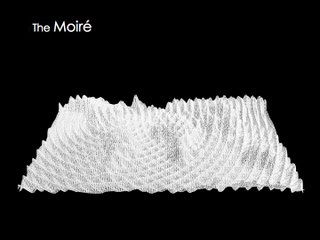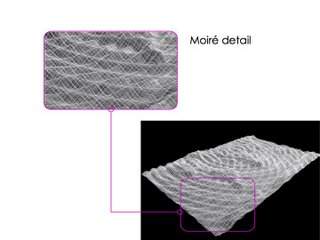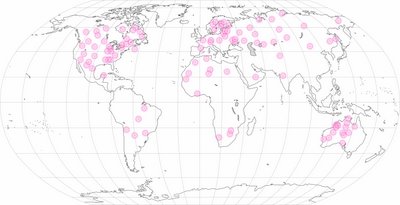http://www.biothing.org/
poli::mat
Wednesday, October 25, 2006
10.25
I recieved some very helpful comments after the review on Monday. The insight of the instructors was eye-opening and helped lead me in a new direction. Here is a review of some interesting points that were raised:
investigate how an impact effects different resistances (water vs. land vs. air)
moire's rebounding-->resistors producing rebounding
investigate wave form/wave distrubances
two simultaneous tsunami's?
resistances: dust settling; can these maps begin to have an identity/material quality that you can resist/ can different parts of the map react differently?
throw things at the "puddle that is the world"
ex: himalayas: concentrate waves? amplify? disperse?
who is spared?
what does an impact carry into the atmosphere?
multiple global scale events: palimpsest of various epicenters
many multiple scale events occuting simultaneously
evidence of flooding from some point, radiation from some point
scale of the ripple, thermonuclear...settlement
radiation tests from nuclear bombs
man made disasters; how they impact one another
There was a variety of comments and in continuing my mapping i hope to redirect my project to encorporate the bolded items.









investigate how an impact effects different resistances (water vs. land vs. air)
moire's rebounding-->resistors producing rebounding
investigate wave form/wave distrubances
two simultaneous tsunami's?
resistances: dust settling; can these maps begin to have an identity/material quality that you can resist/ can different parts of the map react differently?
throw things at the "puddle that is the world"
ex: himalayas: concentrate waves? amplify? disperse?
who is spared?
what does an impact carry into the atmosphere?
multiple global scale events: palimpsest of various epicenters
many multiple scale events occuting simultaneously
evidence of flooding from some point, radiation from some point
scale of the ripple, thermonuclear...settlement
radiation tests from nuclear bombs
man made disasters; how they impact one another
There was a variety of comments and in continuing my mapping i hope to redirect my project to encorporate the bolded items.










Monday, October 23, 2006
10.23
Friday, October 20, 2006
Thursday, October 19, 2006
Monday, October 16, 2006
10.16
rendering of the disturbed earth mesh, a representation of the spread of a shock wave post impact.
detail of ripple
this image shows the comparasson of the regular earth mesh (pre-impact) to the disturbed earth mesh (post-impact) this image is a study of how to layer/combine information.
this image is a study of how to layer/combine information. 
experimentation with controlled disturbance

detail of ripple

this image shows the comparasson of the regular earth mesh (pre-impact) to the disturbed earth mesh (post-impact)
 this image is a study of how to layer/combine information.
this image is a study of how to layer/combine information. 
experimentation with controlled disturbance

Sunday, October 15, 2006
10.15
In reconsidering the assignment I've decided to construct a layering map. This map will condition how the earth as a whole reacts and exists through a terrestrial impact event. When an impact occurs many large scale processes take place including the displacement of atmoshpere, land, water (megatsunami's), the occurance of global firestorms, acid rain, temperature abnormalities, seismic shaking, ejecta deposition, air blasts, and thermal radiation.
This is a lot of information. For this mapping I have selected thermal radiation, ejecta deposition, and air blasts to use as information for layering ontop of a topographic mesh model of the earth (seen below). To gather data I have located a program created by scientists at the University of Arizona. This is a web-based program that calculates the effects of an earth impact. The program can be located here. Using this program I will relate my chosen processes in terms of distance from a given location on the earth. Essentially mapping how the effects of a terrestrial impact diminish as distance from the point of origin is increased.


This is a lot of information. For this mapping I have selected thermal radiation, ejecta deposition, and air blasts to use as information for layering ontop of a topographic mesh model of the earth (seen below). To gather data I have located a program created by scientists at the University of Arizona. This is a web-based program that calculates the effects of an earth impact. The program can be located here. Using this program I will relate my chosen processes in terms of distance from a given location on the earth. Essentially mapping how the effects of a terrestrial impact diminish as distance from the point of origin is increased.



Wednesday, October 11, 2006
Monday, October 09, 2006
earth animation
this is the first step of the animation. next will be to animate a metorite colliding with the earth and deforming its surface.
earth animation
earth animation
Sunday, October 08, 2006
terrestrial impact craters

On the surface, Earth doesn’t look nearly as abused as Mercury or the Moon. However, the earth has been struck by more than 10 times the amount of impacting objects. Over time this has produced approximately 3 million impact craters from 1 km in diameter to more than 1000 km in diameter. You would never see evidence of these impacts by simply studying the Earth’s surface due to geologic processes such tectonic plate subduction, mountain building, erosion, and volcanism. Mountain building crumples impact craters, plate subduction consumes them, erosion d
 issects them, and lava flows and sediments often bury them. These events essentially mask the effect of impact craters on our planet. As a result, only about 160 surviving impact craters have been found and documented so far. The most famous of these 160 impact craters is the 180 km diameter Chicxulub impact crater on the Yucatan Peninsula of Mexico. Studies of this crater and the mass extinction event that occurred on Earth 65 million years ago have shown that impact cratering can affect both the biologic and geologic evolution of a planet. A much better record of what the Earth might look like without its surface changing events can be seen on the Moon because there is no water on its surface, lava no longer erupts from its volcanoes, and plate tectonics have never occurred there. There are over 300,000 impact craters about 1km in diameter on the Moon. Parallels can be drawn between the Earth and the Moon because the craters on the Moon have been created as asteroids and comets hit its surface, and at the same time similar objects hit the Earth. From the Moon’s impact history we can conclude that due Earth's larger size, it would have suffered about 10 times more impact events, or over 3 million impact craters greater than 1 km in diameter.
issects them, and lava flows and sediments often bury them. These events essentially mask the effect of impact craters on our planet. As a result, only about 160 surviving impact craters have been found and documented so far. The most famous of these 160 impact craters is the 180 km diameter Chicxulub impact crater on the Yucatan Peninsula of Mexico. Studies of this crater and the mass extinction event that occurred on Earth 65 million years ago have shown that impact cratering can affect both the biologic and geologic evolution of a planet. A much better record of what the Earth might look like without its surface changing events can be seen on the Moon because there is no water on its surface, lava no longer erupts from its volcanoes, and plate tectonics have never occurred there. There are over 300,000 impact craters about 1km in diameter on the Moon. Parallels can be drawn between the Earth and the Moon because the craters on the Moon have been created as asteroids and comets hit its surface, and at the same time similar objects hit the Earth. From the Moon’s impact history we can conclude that due Earth's larger size, it would have suffered about 10 times more impact events, or over 3 million impact craters greater than 1 km in diameter.
Wednesday, October 04, 2006
Subscribe to:
Comments (Atom)


